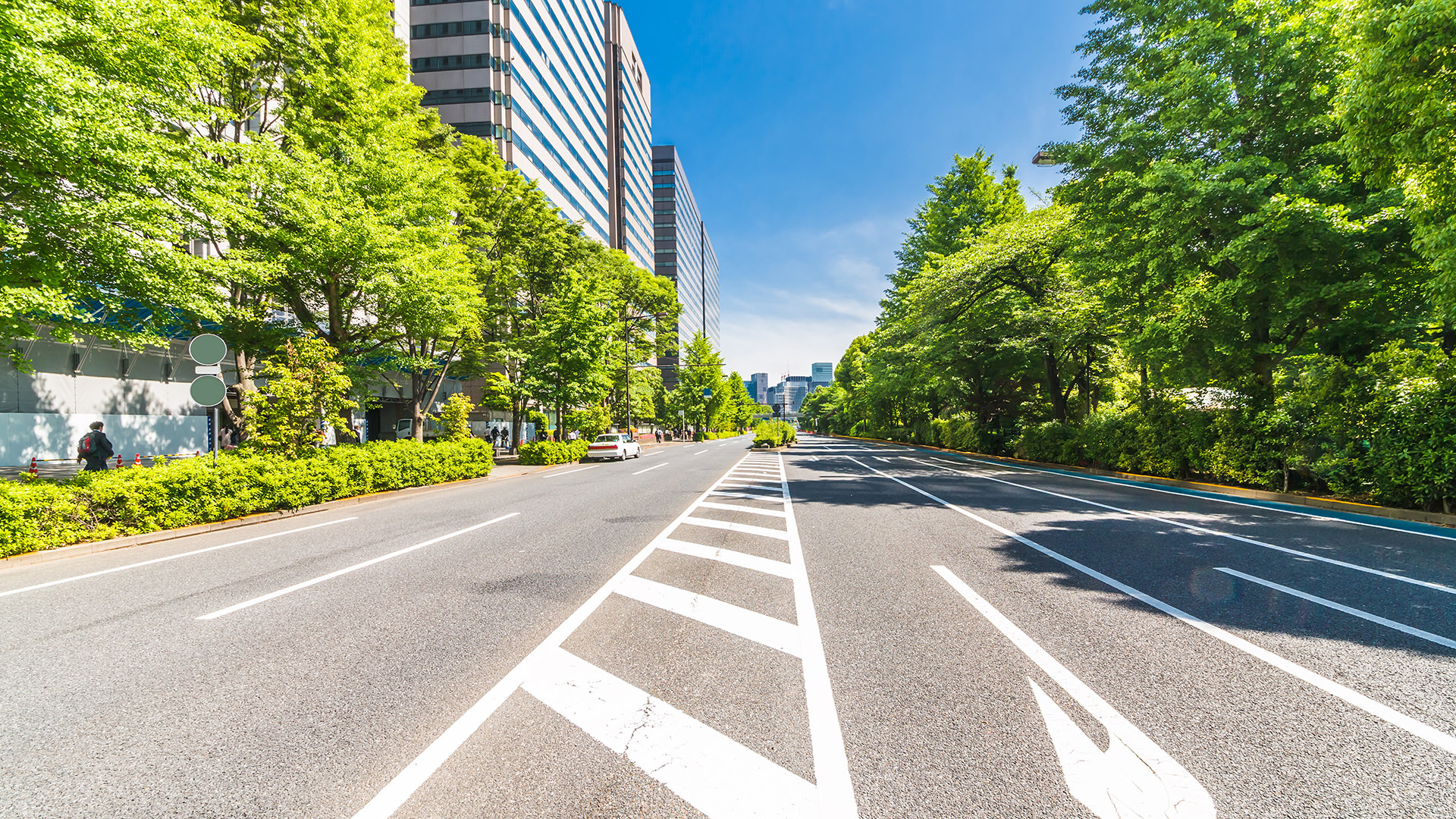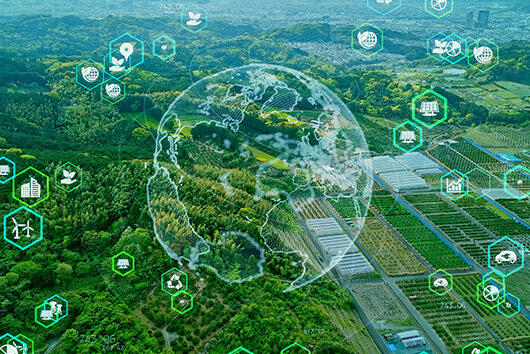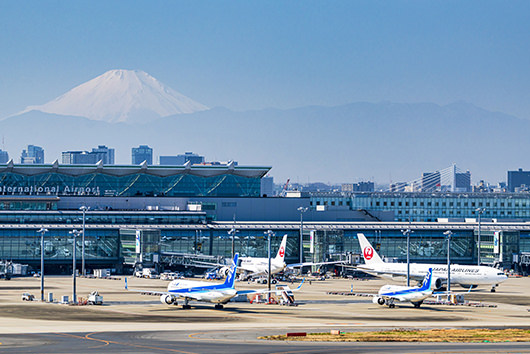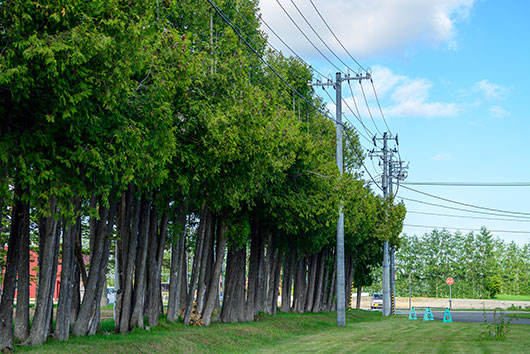The increasing frequency and severity of disasters caused by extreme weather, such as extreme heat, torrential rain, and forest fires, are threatening people's lives around the world. Steady implementation of measures aimed at achieving carbon neutrality by 2050 is essential to curbing the progression of global warming, which is the underlying cause of these disasters. Efforts are also being made in the road sector, which accounts for approximately 18% of Japan's total greenhouse gas (GHG) emissions, and the government revised the Road Act in April 2025 to include a "promotion of road decarbonization," which will come into effect in October 2025. We talked to Hiroyuki WADA, General Manager of Transportation Planning Dept., Social Innovation Div.; Sayo SAITO, Urban Mobility Sec. of the same department; and Nobuo TAKAHASHI, Road Promotion Sec., Road & Highway Dept., Transportation Infrastructure Div., to find out what will be required of road administrators in the future.
INDEX
- Overview of the carbon neutral promotion strategy for the road sector
- New provisions regarding reduction of CO2 emission in the revised Road Act
- Key points for formulating a road decarbonization plan
- What PACIFIC CONSULTANTS can do
Overview of the carbon neutral promotion strategy for the road sector
The "Act to Partially Amend the Road Act, etc." enacted on April 9, 2025, includes four major amendments: (1) strengthening disaster response in light of Noto Peninsula Earthquake, (2) realizing sustainable road infrastructure management, (3) promoting the decarbonization of roads, and (4) establishing basic principles for the development of road networks. (1) primarily involves legalizing road clearance plans in the event of a disaster and strengthening the disaster prevention functions of roadside station, and was implemented first on April 16, with the other amendments coming into effect in October 2025.
The reason behind the clear promotion of road decarbonization now is the need to strengthen efforts in the road sector as part of global warming countermeasures. In October 2020, the Japanese government declared its goal of achieving carbon neutrality by 2050. It subsequently stated that it aims to "reduce greenhouse gas by 46% from FY2013 levels by FY2030, and will continue to strive for an even higher 50%." Furthermore, in February 2025, the government revised its "Plan for Global Warming Countermeasures" for the first time in four years, submitting its Nationally Determined Contribution (NDC, a greenhouse gas reduction target submitted by each country under Paris Agreement) to the United Nations Framework Convention on Climate Change (UNFCCC), aiming to reduce greenhouse gas emissions by 60% and 73% by FY2035 and FY2040, respectively, compared to FY2013 levels.
Currently, Greenhouse Gas Emissions from Japan's road sector are approximately 180 million tons, accounting for approximately 18% of Japan's total emissions. Not only the national government but all road administrators are actively working to reduce emissions, and the road sector is being called upon to achieve the same national targets as the national government: a 46% reduction by FY2030, a 60% reduction by FY2035, and a 73% reduction by FY2040.
Japan's CO2 emissions and the road sector
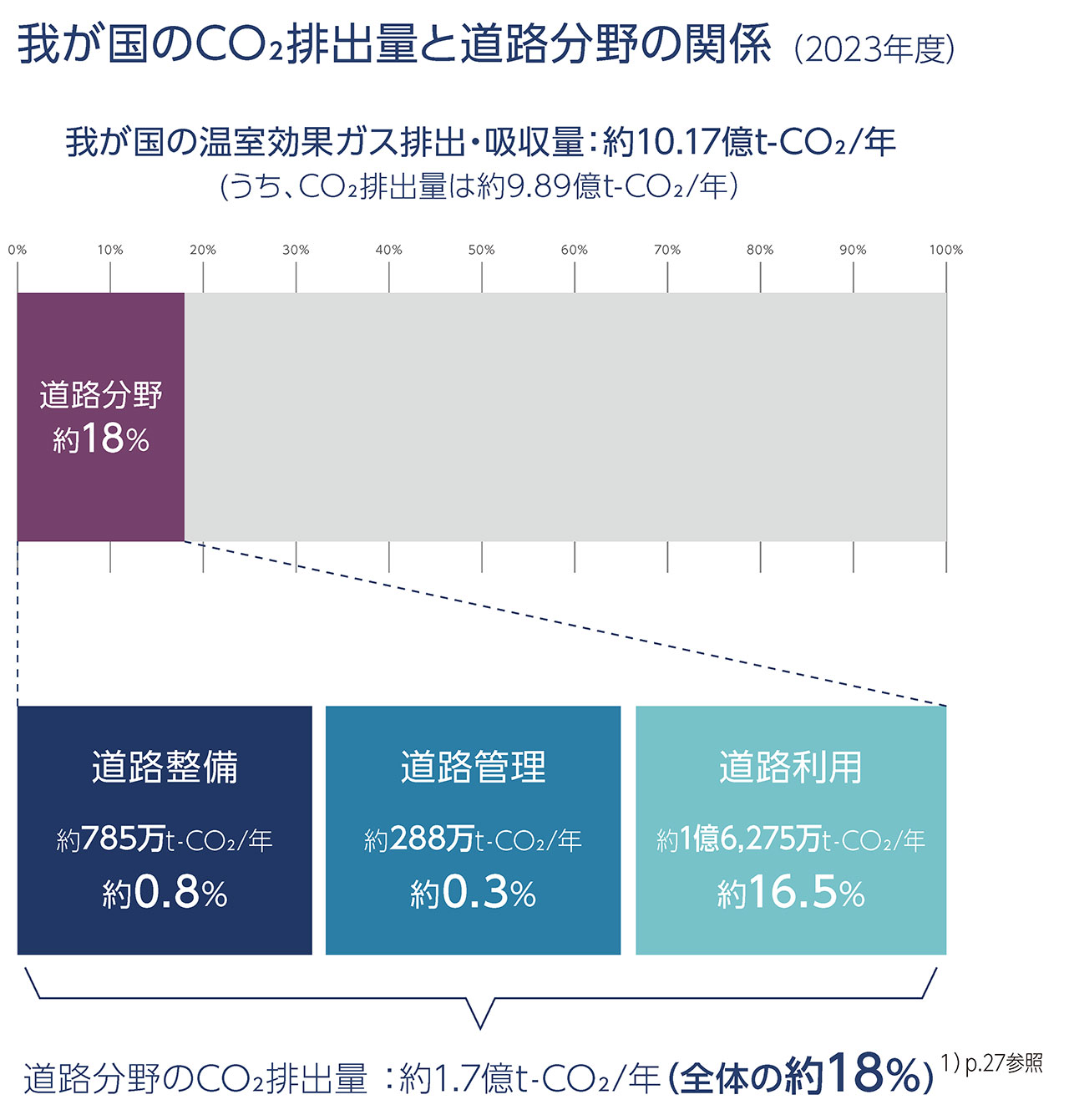
Road-wide CO2 emission reduction targets

New provisions regarding reduction of CO2 emission in the revised Road Act
In order to steadily promote the reduction of CO2 emissions in the road sector, the revised Road Act newly stipulates the following two provisions:
(1) A framework will be introduced in which road administrators (the national government, expressway companies, local governments, etc.) will formulate road decarbonization promotion plans based on the national basic policy for road decarbonization.
(2) The principles for road structure will include consideration for promoting decarbonization, and the standards for permitting the use of facilities that contribute to decarbonization based on the promotion plan in (1) (such as solar power generation facilities and in-motion charging facilities) will be relaxed.
Regarding the schedule for formulating this road decarbonization promotion plan, Ministry of Land, Infrastructure, Transport and Tourism will first publish the Road Decarbonization Basic Policy, the Plan Formulation Manual, and a revised version of the Decarbonization Policy Collection, simultaneously with the enforcement of the revised law on October 1, 2025. Based on this, regional development bureaus and other organizations will formulate policies within FY2025, after which expressway companies and local governments will establish specific measures for achieving the targets, along with a roadmap, for the planning period up to FY2040.
<Schedule for formulating the Road Decarbonization Promotion Plan>
● The revised Road Act will come into full effect on October 1, 2025. At the same time, the "Basic Policy for Road Decarbonization," "Road Decarbonization Promotion Plan Formulation Manual for Local Public Organizations" and "Road Sector Decarbonization Policy Collection Ver. 2.0" will be published.
↓
●By FY2025, the Regional Development Bureau and other organizations will formulate basic policies
↓
From FY2026 onwards, expressway companies and local governments will create and publish specific measures and roadmaps.
Key points for formulating a road decarbonization plan
Going forward, each local government will be required to create a decarbonization plan for the road sector under their jurisdiction in accordance with the guidelines of the Regional Development Bureau. However, due to the nature of roads as social infrastructure, there are a wide range of decarbonization measures, making it no easy task to put together such a plan.
Airports and ports, which are similarly important social infrastructure to roads, are also developing decarbonization plans and implementing specific measures based on those plans. However, these facilities are confined within a certain area and have limited users and purposes, making them "closed facilities." In contrast, roads are "open facilities," with a wide range of users, from individuals to commercial and public entities, and the volume of traffic fluctuates widely. They are also used as public spaces for purposes other than the transportation of people and goods, making the formulation of decarbonization plans inevitably broad and complex. Ministry of Land, Infrastructure, Transport and Tourism has organized its measures into three areas: "road management," "road development," and "road use." The manual also indicates that targets should be set for each area. For the road management area, the CO2 reduction rate and reduction targets for the entire area should be set, along with the targeted initiatives and goals for each initiative.
Examples of main measures taken by local governments in their road decarbonization promotion plans
| Main Measures | Specific Measures | |
| Road Management Field | Switching road lighting to LED | Road lighting accounts for approximately 70% of the electricity used in daily road management. Switching to LEDs reduces power consumption by approximately 56%. |
| Electrification of road vehicles | Switching to electric vehicles, plug-in hybrid vehicles, etc. for patrol cars, etc. | |
| Introduction and utilization of renewable energy power generation facilities | Installation of solar power generation equipment in road spaces, etc. | |
| Road Construction Field | Introduction of low-carbon materials | Introduction of low-carbon asphalt. Use of CO2 immobilizing concrete, etc. |
| Improving productivity through ICT construction | Introduction of low-carbon construction machinery and labor-saving construction. | |
| Road Use Field | Improving the driving environment for electric vehicles | Installing EV chargers at roadside station, etc. Development of a wireless power supply system for electric vehicles while in motion. Installation of hydrogen stations. |
| Introduction of self-driving vehicles (buses) | Improving the driving environment and increasing social acceptance | |
| Promoting bicycle use | Installation of shared bicycle ports. Expansion of bicycle lanes. | |
| Reorganization of road space | Widening of sidewalks. Creating "roads that people want to walk on" using the "pedestrian-friendly roads" (hokomichi) system. | |
| Countermeasures against traffic congestion | Reducing traffic congestion and bottleneck crossings. Promoting transportation demand management (TDM), including expanding rail use and introducing BRT (Bus Rapid Transit) systems. | |
| Improving logistics efficiency by promoting the introduction of articulated trucks | Traffic divisions and expansion of priority parking spaces at SAs and PAs. |
Created by PACIFIC CONSULTANTS
As is clear from the main policy examples, even if some individual measures are not primarily aimed at "road decarbonization," some are already being demonstration experiment or underway in various local governments. What is necessary in future planning is to reorganize measures, including those already underway, from the perspective of "road decarbonization," and then create a roadmap up to FY2040 that specifies how much CO2 reduction will be achieved, by when, and through which areas and measures. Furthermore, some specific measures are difficult for a single local government to implement. In these cases, it will be necessary to consider collaboration with the national government, expressway companies, and surrounding local governments.
What PACIFIC CONSULTANTS can do
PACIFIC CONSULTANTS has been working on projects such as "airport decarbonization," "port decarbonization," "traffic congestion countermeasures," "road space reorganization plans to meet diverse needs such as pedestrian and waiting space needs," "introduction of self-driving buses," and "support for the introduction of ZEB (Net Zero Energy Building)." We have also supported the formulation and implementation of decarbonization measures in various fields, such as promoting Power Producers and Suppliers (PPS) through our group company Pacific Power.
At the same time, he has been centrally involved in compiling Ministry of Land, Infrastructure, Transport and Tourism's technical guidelines, "Technical Considerations for the Installation of Solar Power Generation Facilities on Roads" (March 2023, Road Bureau, Ministry of Land, Infrastructure, Transport and Tourism) and "Guidelines for the Installation of Charging Equipment for Electric Vehicles, etc. on Roads" (May 2023, Road Bureau, Ministry of Land, Infrastructure, Transport and Tourism), as well as the production of the "Road Space Utilization Guidebook" (The Japan Civil Engineering Consultants Association), which compiles various ideas for new road usage and approaches, including how to obtain road use permits, thereby supporting the development of national policies. The guidebook compiles the various considerations and procedures that people and organizations who want to devise innovative ways to use roads need to consider before actually utilizing road space, as well as the process for continuing the utilization that has been realized and linking it to regional revitalization, and is already being put to use.

Furthermore, with a view to contributing to solving social issues such as carbon neutrality, we have been actively involved in "public space management (improving traffic congestion)" and have participated in social demonstrations of "turning road spaces into plazas." For example, in May 2022, as a member of the Yokohama Park Line Promotion Council we worked on "turning road spaces into plazas" on Japan Boulevard, located in the waterfront area of Yokohama city center, based on the pedestrian convenience improvement road system (commonly known as "Hokomichi") established by Ministry of Land, Infrastructure, Transport and Tourism .
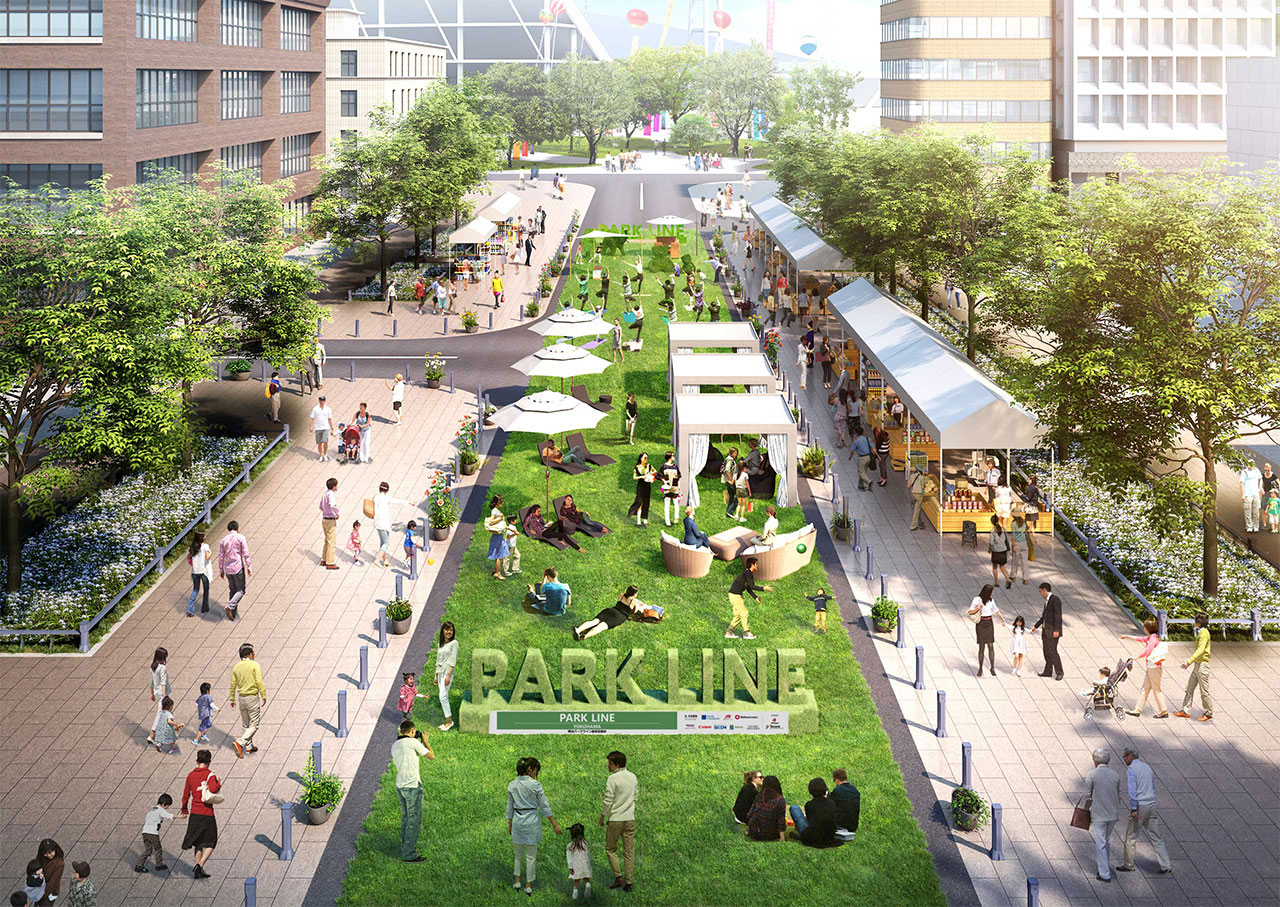
PACIFIC CONSULTANTS is unique in that it has experts in a variety of fields all under one roof, including not only road experts but also engineers in the fields of mechanical and electrical equipment such as lighting essential for road operation, architecture and structure, transportation policy, DX promotion, environment and GX promotion, and infrastructure maintenance and management, as well as a company within the group that is engaged in power generation projects. We will continue to utilize this comprehensive strength to support carbon neutral efforts in the road sector.



